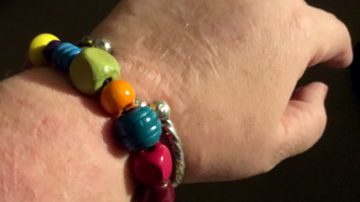So… I want to say something about this question: How do you tell a story – perhaps, tell your story?
No time? (tl:dr): You don’t have to begin at the beginning; don’t try and think about the ‘whole thing’ but focus on moments and details; think about the everyday textures of life – time, place, weather, colour, sound, feeling; don’t feel you have to have a formal ‘finish’ to the story; you don’t have to ‘explain’ everything; remember that stories work at the level of feeling and emotion, as well as thought; you can retell your story any time you like.
Firstly, it’s important to say that although I’m using the word ‘story’ in this piece, a better term might be ‘representation’, because I don’t want to exclude the possibility of using poetry, photography, imagery – and also because ‘story’ is quite a loaded term. It might imply something which has to have a beginning, middle and end – or which lays things out clearly in a documentary style. And while those kinds of stories are fine, stories (representations) can also communicate in other ways.
Stories are tools we can use to make sense of our lives, our relationships, and our world – and help us to connect our personal experience to the world we live in, and to the lives of others. Stories are about more than the transmission of information (‘telling’) – they also produce new insights and change understandings. Stories are ways we can encapsulate and articulate personal truth, and then, perhaps, communicate that truth to others. But there’s more to stories than this.
What’s most interesting for me about stories is their potential to ‘remake’ the world: this happens from their capacity to produce new meanings, and to introduce uncertainty, questions, doubt.
To make a story is often to make connections– for instance, between feelings, events, thoughts, people, relationships, history, places. Meanings emerge from the way a story makes these connections – and therefore attributes cause and effect: “this happened because of that, and therefore I felt this”. But – and this is important – we can change the meanings of our stories by making different connections, or by attributing new significance to the connections we draw. While we can’t change the events of our lives, we can reinterpret them. Often such reinterpretations happen in the light of subsequent knowledge and understandings we acquire, including through the influence of others’ insights and stories. The meanings of our own stories, therefore, can evolve and change. So, the kind of truths which stories embody are not scientific: rather, they are personal – reflecting and embodying our subjective understandings of ourselves and our relationship to the world.
A story, then, is not a scientific form of discourse. And this is also evident in that stories allow us to move within the realms of imagination and poetry. Stories do not require us to produce definitive conclusions, rather they allow us to invoke profoundly human experiences such as hesitancy; unknowing; incomplete understanding; contradiction, emotion, and irrationality; transcendent joy; wonder; and utter despair.
In healthcare contexts, stories seem ubiquitous these days. However, the types of stories which are out there often appear to have little to do with the rich traditions of narrative. Stories are used in instrumental ways – to prove a point, to back up a conclusion, to advance a campaign. I don’t want to say any of this is necessarily a bad thing, but there is a lot more to narrative than this.
The most powerful stories work at the level of thought and feeling. They don’t spell everything out neatly. They produce a felt sense of a reality in the reader. It’s impossible to produce a definitive ‘recipe’, but the most memorable stories often achieve their impact through techniques such as paying attention to detail, setting the scene, giving a sense of time and place and mood.
Look at this extract from Virginia Woolf’s A Writer’s Diary:
No, it’s not physical silence – it’s some inner loneliness – I was walking up Bedford Place is it — the straight street with all the boarding houses this afternoon — and I said to myself spontaneously, something like this. How I suffer. And no one knows how I suffer, walking up this street, engaged with my anguish, as I was after Thoby died — alone; fighting something alone. But then I had the devil to fight, and now nothing. And when I come indoors it is all so silent — I am not carrying a great rush of wheels in my head — yet I am writing – oh and we are very successful – and there is – what I most love – change ahead.
What an extraordinary piece of writing this is! It evokes so much emotion and confusion and uncertainty. It doesn’t spell everything out for the reader, yet we get a felt sense of a person, and of the deeply human experience of being conflicted, or trying to work things through. I love the way Woolf invokes and describes a specific place in a piece of writing which is about her inner world. The drama of our thoughts and feelings, our hopes and fears do play out at specific times, and in specific places. So too, Woolf’s reference to another time in her life – and another person – works to draw out the dimensions of personal feeling by situating a moment within the historical context of a life. And for me it is this kind of detail which helps to bring this writing and experience to life.
I’ll finish by repeating the tips I put at the beginning of this piece… adding a few, and expanding on others.
Telling your story is a creative act – you may be describing the past, but you are doing this in the present. When you tell your story you are creating something new.
You don’t have to begin at the beginning – Describing a moment or event can open a window onto the bigger story you want to tell
Don’t try and think about the ‘whole thing’ but focus on moments and details
Include details of the everyday textures of life – time, place, faces, weather, colour, sound, feeling;
Don’t feel you have to have a formal ‘finish’ to the story – it’s fine, and often better, to leave some things unsaid
You don’t have to ‘explain’ everything;
Stories work at the level of feeling and emotion, as well as thought;
Never think that your story has to have a ‘message’ – if a story produces a feeling, or provokes questions, that’s great
You’re in control – you can (and should) withhold information you don’t want to share.
Using your imagination is fine – it doesn’t matter if you can’t exactly remember every detail of the weather, the place, the time of day
You can retell your story any time you like – this is your version of your story today: tomorrow you might choose to tell it in a different way, with different meanings….



